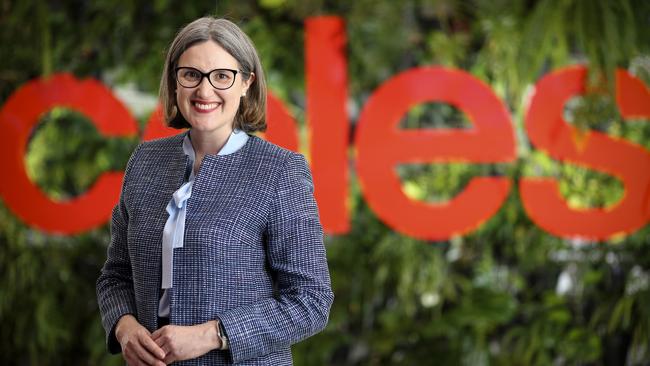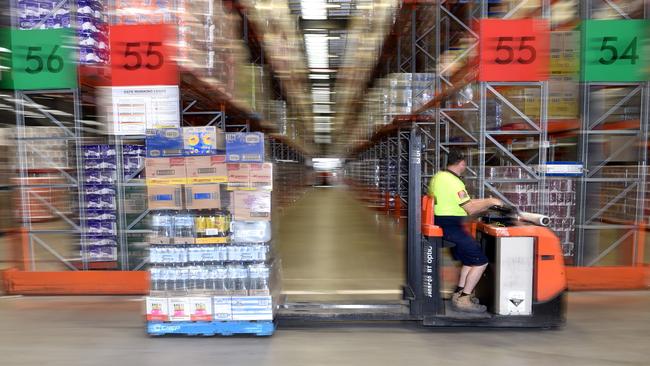Why Coles’ robot revolution promises to change retailing
The supermarket giant is on the cusp of a long-awaited step change in the way it gets the food on the shelves or to your doorstep.

Business
Don't miss out on the headlines from Business. Followed categories will be added to My News.
Coles is on the cusp of a long-awaited step change in the immensely complex way it gets the food on the shelves or to your doorstep through home delivery.
After delays and cost blowouts, the near $1bn investment into a series of robot powered warehouses will progressively come online over 12 months and rapidly speed up the ability for the supermarket major to get goods around the country.
And while the back end changes won’t mean much for the customers on the day-to-day, Coles is betting that over time the new robot-powered warehouse and higher volumes will progressively bring down distribution costs and ultimately lower prices. This will bring the battle to bigger rival Woolworths.

First announced in 2018, the investment is across two legs. One is Project Witron involving the construction of two monster warehouses – one outside Brisbane and another in Kemps Creek in Sydney’s west. These are smart warehouses that use automation to load and unload trucks to move the so-called big brown boxes around Coles network.
The second – which has been the source of many delays as the scope of the project changes – are customer fulfilment centres. These are going to be closely-watched as they bring sophisticated robot technology into Australia at massive scale to pick and pack specific online orders for customers. Each site has up to 1000 robots working around the clock filling orders as they arrive.
As Coles boss Leah Weckert points out, this will efficiently meet the demand of highly individualised order, such as one packet of cornflakes, five apples and dishwashing liquid in one order and a completely different basket of goods for the next.
Coles are using UK-based smart logistics player Ocado to essentially build, run and operate the warehouse using its specialised robot technology.
The test run for Coles for the Brisbane distribution warehouse was last Christmas, where it moved its entire Queensland network over to the new Redback-based site.
The difference quickly became evident. Even through ramp-up and testing, Coles put a record amount of cartons through the Redbank site than anywhere else in its distribution network.
“It was a big step change in terms of performance,” Weckert says.
Kemps Creek will begin to come online in coming months, giving a boost to Coles’ NSW network. Packaged goods are even now being loaded into the site, showing it is almost ready to go. This will then be fully live over the next few months.
The next big test for Coles will be switching on its Ocado customer fulfilment centre in Wetherill Park, also in Sydney’s west, in the next three months as it gets ahead of demand for online sales.
This warehouse is incredibly complicated as it allows for a mix of cold, frozen and even baked goods alongside fresh and packaged to come out of the one warehouse. In essence, it’s a giant supermarket without shoppers, all designed to deliver into digital orders. The second site in Victoria has been hit with delays on design, but this is now expected by next financial year.
Just in time
The two Ocado warehouses are arriving just in time for Coles. Online sales for the supermarket are booming – increasing almost 35 per cent in the March quarter alone. At $856m during the quarter, online sales are almost 10 per cent of network sales.
Weckart says online is being driven by three trends – more customers going online for the big weekly shop; customers “topping up” their weekly shopping through online. Then there are “urgent shoppers” who might be after nappies or the like are choosing express delivery and getting goods between 60 and 90 minutes.
The billion-dollar investment by Coles in technology and productivity comes with the background to the Greens-led Senate committee into supermarkets prices. And while there have been low level calls from some like the Greens to break-up the big supermarkets Woolworths and Coles, it is long term projects like these that are only possible for business that can spread the significant upfront costs across millions of customers.
Thankfully the Albanese government has pushed back on break-up calls, however it is still mulling ways to keep the pressure on supermarkets.
Here, politicians can’t ignore the benefits of economies of scale. Like Amazon does on a global scale, Coles and Woolworths collectively invest billions trying to find savings at every point of distribution.
The ability to move goods around more efficiently results in lower cost to customers. It is also the glue that underpins the proposition of statewide or national pricing, that a forced break-up would bring an end to it all.
In looking at the scope of competition across supermarkets, it’s not just the different amount of branded stores a customer can walk into. The Coles’ investment shows the real competition is taking place at the back end and this where the likes of Amazon have forced supermarkets to lift their game.
johnstone@theaustralian.com.au
Originally published as Why Coles’ robot revolution promises to change retailing



